- Grade Levels
- Search Site
- Language Arts Topics

Editing Worksheets
Unfinished work often needs a good bit of editing to be polished. It may be a simple spelling or punctuation error. The grammar may have fallen of the rail a bit. The sequence of events may be better reordered to help the reader along. In most cases, we are editing our own work or working in a peer review capacity and editing or friend's work. Most people find it difficult to edit their own work because when they re-read their own pieces, they read it as it was intended to be read. On the worksheets below students will edit the works that have been written for them.
Editing Worksheets To Print:
The Right (Write) Stuff - Some of these words just don't fit. Visualize a picture in your mind for the sentence as you read. Use your picture to cross out and correct each homophone. Then, answer any questions.
Righting Sentences - You will need to make a series of adjustments to a selection of sentences that are paced in the right direction.
Correct It Out - You might find some familiar sayings here. See if you bring these up in your own mind.
Spelling, Punctuation & Capitalization - Clean these sentences up by making all the changes that are requested on each exercise.
Visualize the Picture - You will work on some really jacked up sentences such as: Write now these just don't make any cents. (Get it?)
Pool It In - What are they trying to say? We'll we are not giving you extra help. You need to fix these all on your own.
Chocolate Raft - Wow! Some of these are hard sentences. If this was your own work, I would just right new sentences altogether.
Polar Bears - You might need to change the whole thought process here. There are multiple sentences here that you will need to determine the start and end of.
Tigers and Pets - These passages are themed around the concept of animals. They are much larger passages that require a good amount of work on your part.
Time For Marshmallows - A little chemistry for you. These are science related passages that include anywhere from four to five sentences.
Pen It In - Visualize a picture for these proverbs and adages. Use the picture and writing rules to make corrections to all of them.
Eggs In A Basket - We work on one-liners here. There are all different types of errors for you to work on.
Dragon Your Feet - This is a great title that just jumped into my head. Read all of these sentences very carefully.
Dripping Water - Remember your basic grammar and punctuation rules and you should be fine. These exercises include the largest helping of text.
Tube Country - Does this worksheet come easy for you? It should if you completed all the others.
More Editing Worksheet Topics:
Analyzing Word Choices - Be selective about your choice of language can indicate a great deal about yourself. We will show you how to improve your ability with this.
Dangling Modifier - Learn how to change sentences that just do not flow right.
Editing and Revising Your Writing - Being critical of yourself is not the easiest thing in the world.
Grade 1 Peer Writing and Editing - This is usually where like to start students off working with productive peer reviews.
Guided and Peer Writing Revision - This is more geared toward the middle school level student.
Paragraph Correction - A nice extension that requires pacing and sequence to control to layout of the language.
Revising and Editing Writing - This is aimed at the elementary level and has students learn to make this a multi-step process.
Revising, Editing, and Rewriting - Students start to learn the concept of a workflow and pacing system for themselves.
Writing Process - This is used to help students begin to create their own lengthy body of work.
Writing Revision - A nice system for middle school students to work on that next level work.
Tips for Editing Your Own Work
The one thing about editing a work, whether you wrote it or it is another's work, is that many people seem to have their own process. Yes, they have a basic outline of steps to complete the edit. How they take those steps differs from person to person. Below I share the process of editing that I use. You may be able to add some of my tricks to yours.
The first thing I always do is read the entire work and check for spelling, punctuation, and grammar errors. I follow this up by writing a sentence complete summary of the work. If it is a lengthy work, the check for a proper sequence and make sure the paragraphs complement one another as it is presented to the reader. The next thing I ask myself is "Does work set out to do what it was intended to do?" If the work is explaining something, did it cover all the aspects of what it was designed to explain? I then go back through each paragraph and make sure there is enough context for the reader to grasp the goal of each paragraph. My next step is to look for overuse or repetition in each paragraph. I find this to be a frequent problem and some writer's are very prone to have this habit. I look back at my original one-sentence summary and make sure every paragraph supports that statement.
Editing and revising your own work sounds like a complex task especially after investing hours into writing a document. However, you cannot get away with proofreading and editing at any cost unless you have a professional for this purpose. It takes time and a lot of practice to edit a document flawlessly, but remember it's worth it. Below are a few simple ways to remove errors from your work.
Take a Small Break
Never start editing your work right after you have finished writing unless there are time constraints. This is because by that time your eyes are tired and it becomes difficult to find errors. Take a small break to rejuvenate yourself. Start editing when you feel your energy level is good enough to work.
Print it Out
Never rely on technology to edit your work. Screens tend to make your eyes feel tired; therefore, you are unable to give the right amount of time to it. It's always the best to print your work and highlight the mistakes with a bright colored pen or a highlighter.
Read it Aloud
Read your writing aloud once you are done with it. Doing this helps you to identify problematic areas in your writing. Also, if you find yourself getting stuck in several places, then it means your writing does not have a good flow. In addition to this, this will also help you figure out the content and tone are appropriate for the intended audience.
Don't Show Leniency
Simply imagine that it's not you, but your examiner checking your work. Don't even let go of minor spelling mistakes. Correct each error immediately to speed up the process.
Use Grammar Correcting Software
Technology has made everything infinite times easier than in previous times. There are multiple grammar check websites and apps. Grammarly is the most recommended software for this purpose. It detects issues in spellings, sentence structures, punctuation and grammar.
Attaining utter perfection in any written work is the ultimate desire of every writer. This perfection is required not only in terms of the storyline and topic of the book or how it is being addressed, but also encompassing the most minor aspects of a work too. For example, how flawless the sentence structure is and how much attention has been paid to the spellings and grammar in the text.
No matter how interesting a work is or with how much care the author has written it, it can never achieve perfection unless it has been revised, edited for flaws, and rewritten in some parts before it is finally published. An author spends a lot of time on his work after finishing it to edit, rewrite, and revise it.
Here are a few tips to do all these actions the easier and faster way:
Highlight and Mark While You Are Writing for the First Time
The process of editing, rewriting, and revision must be in your mind even when you are writing the work for the very first time. While writing in flow, you are sure to encounter many points in your writing that you think can be made better afterwards. This may include a vague word choice, a complex sentence structure, and unnecessarily long paragraph, or anything else. It is better to keep on highlighting all these flaws with different colors so that while you sit to edit your work, you know what to do first.
Think as a Reader
When you are reading your own work to make it better, try reading by putting yourself in the reader's shoes. Search for the place where they can find it hard to understand the text and edit according to their needs.
How to Spot Mistakes in Grammar?
It is very important to use correct grammar in any type of writing. Academic writing especially requires you to pay immense focus on grammatical correctness. Mistakes of grammar in any writing depict the naïve-ness of a person. It shows that the writer does not have excellent command over the language. It can also damage their credibility. Hence, it is essential to make sure that you spot every grammatical error in your piece of writing. Here are a few common grammatical errors that you can spot in your writing before submitting it.
The subject-verb agreement
This is one of the most common grammar mistakes that is made by students. The subject-verb agreement is a necessity for a sentence. They both should agree and complement each other. If the subject of the sentence is singular, then the verb should also be singular. If the subject of the sentence is plural, the verb should also be plural. You can spot this mistake by reading the sentence and identifying the subject and verb. After that, notice if both are agreeing and complimenting each other in terms of singularity or plurality.
Missing Commas
A comma is an important element of English grammar. It enables the reader to distinguish between different parts of the sentence. It helps a lot in making sense of the sentence. Check for missing commas in the sentence. There should be a comma after an introductory phrase, word or clause.
Missing Apostrophe
One of the most common grammatical mistakes is that people often tend to forget to use an apostrophe in "its". An apostrophe should be used with "it's" if the word means "it is" or "it has".
The Process of Revising Your Own Work
The revision of any work is very important because anyone can make mistakes when they start writing at first. Here is the process through which you can revise your own work.
When you are done writing your first draft and want to eliminate any errors from it, the first step that you can take is to read aloud the entire passage. By reading it out loud to yourself, you will realize what your work actually sounds like. This process will highlight any mistakes for you. You will get to know the errors that you made in the sentence structure. It will also tell you if you have used any wrong choice of words. You can edit all the mistakes when you are done reading it out loud.
Use Spell Check
Any written piece should be free of any spelling mistakes. This is because spelling mistakes can make the draft look very casual and unprofessional. Such mistakes can ruin the credibility of the writer. It is very easy to get rid of the spelling mistakes that are present in your written piece. You can run your draft through a spell check. It will let you know what words you have spelled wrong. It will also correct the mistakes for you.
Look For Grammatical Errors
After the spell check, come the grammatical errors. Grammatical errors can cause a lot of problems in your essay. Such mistakes can cause a lot of confusion in your draft. You can read your draft again and again to spot any mistakes in the usage tenses. Punctuation should also be perfect so that the information can be smoothly presented for the readers. You can run a grammar check a couple of times to ensure that your draft is free of any errors.
The Steps to Writing Revisions
Writing process involves many steps. Revision is the third and the most important step of this whole process. In this step, writers take a final look at the work created by them after which they revise it, alter it, and review it for weak points if any. No writer can pass on his or her work to someone else without revising it since it is a very important step in the process of writing. The revision stage is sometimes summed up in A.R.R.R approach which stands for adding, rearranging, removing, replacing. This approach is discussed in detail below:
In this step, you as a writer will look for the: information gaps, missing data, facts, and figures and will fill these gaps. One good tip is to go back to your prewriting notes and verify if all the headings and relevant information are being added. One good technique is to ask your friend to read your writing work, ask him or her for mistakes and other things that can confuse the reader.

Rearranging
While going through your writing, you may need to rearrange sections or paragraphs. If your writing lacks in the beginning but packs a punch at the end, you need to rearrange it. Rearranging paragraphs is also done for a better flow of arguments.
While revising, you may find some irrelevant information that is not according to the thesis statement and is confusing the reader. Such type of information must be removed during revision. In other cases, when you exceed the word count, unnecessary information should be removed. Unfamiliar words that are not adding any meaning to the content should also be removed.
Some sentences or paragraphs that are not constructed appropriately must be replaced with accurate ones during revision. Replacing is also done if you want to add important information in place of an ambiguous one.
Teachers: Upgrade Now
- Print all 25,000+ worksheets
- All grade levels and topics
- Save endless hours of your time...
- Answers to everything too!
Get FREE English Worksheets In Your Email
- How We Are Aligned To The Common Core
- Educator Resources
- Privacy Policy
- Newsletters
© English Worksheets Land . All rights reserved.
Reading Worksheets, Spelling, Grammar, Comprehension, Lesson Plans
Editing and Proofing Worksheets
A vital skill for young writers is to be able to revise and edit their writing. Recognizing an error in spelling, punctuation, grammar, and word usage takes some practice. The worksheets listed below give your student this important practice. You may use them for free in your classroom or at home. To read more about them or to download a printable PDF, simply click on the title. Check out all of our writing worksheets !
Make the Spelling Corrections
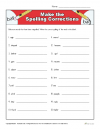
Encourage your students to look for spelling corrections with this “Correcting, Proofing, and Editing” worksheet.
Correct It!
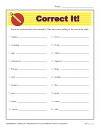
Use this “Correcting, Proofing, and Editing” activity to teach your students the importance of proofreading by correcting spelling mistakes.
Correct the Paragraph
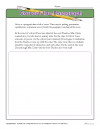
Have your students proofread and correct paragraphs with this helpful editing worksheet.
Correct the Spelling
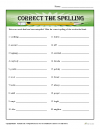
Teaching your students to correct spelling is made easier with this helpful, printable writing activity.
Correcting Mistakes: Rewrite the Sentences
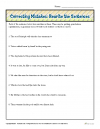
Encourage your students to check for sentence mistakes with this “Rewrite the Sentences” classroom activity.
Spot It: Unnecessary Words
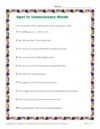
Practice identifying unnecessary words with this printable worksheet on editing and proofing. Students will be asked to read through a series of sentences and circle the ones that contain unnecessary words. This activity is great for use both at home and in the classroom.
Spot It! Faulty Coordination
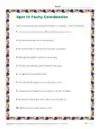
Help your students with their reading and writing skills by using this printable activity in class. With this worksheet on editing and proofing, students will be asked to read through ten sentences and identify the ones that contain faulty coordination. Ideal for 5th – 8th grade, but can be used where appropriate.
Correcting Mistakes in Sentences
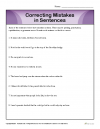
Use these printable learning materials to teach your students how to correct sentence mistakes.
Editing and Proofing a Paragraph
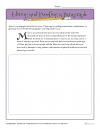
Your students will further their editing and proofing skills by correcting a paragraph in this printable classroom worksheet.
Find the Misplaced Modifiers
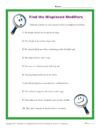
See if you can identify the other misplaced modifiers in this printable grammar worksheet. This grammar activity for middle school students is great for improving reading and writing skills. While it is ideal for 7th – 9th grade, it can be used where needed. This misplaced modifiers activity is perfect for both parents and teachers to use in the classroom or at home.
Spelling: What’s Wrong, and What’s Right?
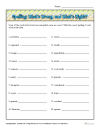
Your students will learn the difference between right and wrong in spelling with this “Proofing and Editing” worksheet.
Spot it! Which Are Grammatically Correct?
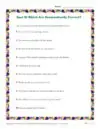
With this printable worksheet on editing and proofing, students will be asked to circle the number of the sentence that is grammatically correct. Ideal for 6th – 12th grade students, but can be used where needed.
Correct Spelling: Right or Wrong
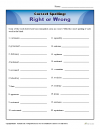
In this “Right or Wrong” classroom activity, your students will correct spelling mistakes while proofreading the sentences on this worksheet.
Find It! Faulty Parallel Construction
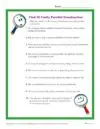
Practice recognizing faulty parallel construction by completing this printable worksheet. This activity focuses on refining editing and proofing skills. It is ideal for high school students, but can be used where appropriate. Because it is made easy to print, this worksheet is great for use both at home and in the classroom by parents, teachers, or students. Click the link below to download and print the worksheet to get started.
Paragraph: Proofing and Editing
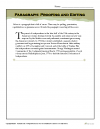
Use this “Printable Writing Worksheet” to help get in the routine of proofing and editing.

IMAGES
COMMENTS
A worksheet to help students learn how to revise and edit an essay. It includes a reverse outline exercise, a grammar and spelling checklist, and a revised essay example.
Revision and Proofreading Checklist The following questions should help you assess the general quality of your written work. You may wish to copy this worksheet for each paper that you write. Paragraph or Essay Structure Consider the essay’s or paragraph’s content and its overall organization.
Revision is the third and the most important step of this whole process. In this step, writers take a final look at the work created by them after which they revise it, alter it, and review it for weak points if any. No writer can pass on his or her work to someone else without revising it since it is a very important step in the process of ...
Help your students with their reading and writing skills by using this printable activity in class. With this worksheet on editing and proofing, students will be asked to read through ten sentences and identify the ones that contain faulty coordination. Ideal for 5th – 8th grade, but can be used where appropriate.
Revision Worksheet Breaking it down to paragraphs:. 1. Docs your paragraph contain a topic sentence with a clearly stated controlling idea? Is it specific enough? 2. Have you provided enough information for your audience to understand your point? 3. Have you taken out any information that doesn't directly relate to the topic sentence? 4.
Argumentative Essay: Revision Checklist REVISION CHECKLIST: Directions: Find, highlight, and revise these elements in your informational article. **If you don’t have one of these things, ADD it!** _____ The essay includes an attention-grabbing hook. _____ The essay includes an introduction paragraph that clearly defines the topic and your